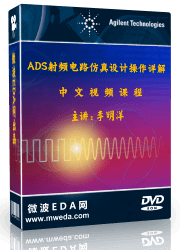- 易迪拓培训,专注于微波、射频、天线设计工程师的培养
Frequency multiplication with a Pierce oscillator in ADS
I designed a Pierce oscillator in ADS, working @ 50MHz. Now I want to try a frequency multiplication to have it at the 3rd or 5th overtone.
Now my question, where and what kind of LC-circuit do I have to place in my circuit for selecting an overtone?
Here`s my schematic...

Would be great if somebody could tell me what and where I have to place a LC-circuit, thanks.
t2theommy
There are two ways you can do this.
1) actual frequency multiplication, as you title implies. You would add on another circuit at the output of the oscillator that used diodes, transistors, fets, digital gates, etc to generate a X5 signal, and then follow that by a clean-up bandpass filter.
2) make a 5th overtone oscillator, and have the fundamental oscillator output frequency be 5 x the crystal resonant frequency. To do that, you need to model the crystal to be resonant at 5 x the frequency, which I do not see in your schematic. You model the crystal with only one L-C, where as you need another two at 3 x F0 and 5 x F0. Also you need to replace C6 with some L-C network so that the oscillator as a whole is not able to run at F0 or 3 x F0.
First, your oscillator is not a Pierce, is a Colpitts.
Second, referring to the initial question, in this crystal oscillator you can place in the collector of the transistor a parallel LC resonant circuit tuned on other harmonics.
On the other hand, looking to your schematic I don't understand the role of C11, and also C12 is in parallel with C9. The feedback capacitors are C9 and C10.
I think you have to remove from the circuit both, C11 and C12.
Thanks to you both, the parallel LC circuit worked fine on my example. The two capacitors C11 and C12 were just there for some finetuning in frequency, didn`t need them for real.
- - - Updated - - -
Ehm, but there is another question I have... :D
When I want to block everything, except the 5th harmonic for example... how do I tune the LC circuit? I mean, with a 50MHz quartz, i would have to block everything up to 200MHz or something like that...
Sorry, but I`m new to this topic and I`m a little confused...^^
To select 5th harmonic, tune the LC circuit on 250MHz. For better rejection of other harmonics can add another LC circuit resonant on 250MHz coupled to the initial one.
The output level will drop in this situation.
Mhh, okay... guess I know what you mean. But, if I tune my LC circuit to 450MHz (the ninth of the 50MHz quartz) - only my ninth overtone is rejected downwards, it works as a band reject filter.
I took a screenshot of the Harmonic Balance simulation and of the schematics.


You have to pick-up the signal from the collector, maybe using another inductor inductive coupled to L3.
for frequency multiplication(for ODD harmonics generation) ,
we generally use HSMS-281X series diodes and arrange them in a bridge formation as mentioned by the application note
http://www.techlib.com/files/rfdesign2.pdf
this rejects the even harmonics and after tuning the input LC circuit you can get the 9th harmonics of the fundamental with out much loss as compared to your method.
i have designed a circuit with which i provide an input of 120MHz to the circuit and take out 840MHz which is the 7th harmonics of the fundamental freq.
I just tested the method posted by vfone, and it worked. Not very good for the first time, but it was ok.
But the frequency wasn`t arround 450MHz... it was 416MHz. So I did some finetuning @ the quartz and the parallel LC-circuit and got the 450MHz.
But that tuning took me to the 7th overtone, as you can see in the picture below. And somehow I should try to get a better sinus, `cause that`s not what I want to have
at the output... ^^

And shashy.br - thanks for your hints, but I shouldn`t use diodes or something like that for multiplication. This work shall be done with only overtone-quartz and LC-circuits...
Doing this kind of harmonic generation using just one active device is tricky. Because you have to do a compromise, first to have a distorted signal rich in harmonics, and second, the selected harmonic to be a sinus as clean as possible. Just adding more filtering at the output it will clean the desired signal.
In these situations better than using a band pass filter at the output is to use a high-pass filter and a low-pass filter in series, both letting the desired signal to go through and reject the unwanted harmonics.
Okay, everything worked pretty good. Thanks for your help. There`s only one last question I don`t really understand... when I have my oscillator @ 50MHz like in Post #1, I have
my output at the emitter. But when I work with the frequency multiplication I have to put my output at the collector, because otherwise it won`t work... But WHY? :D
I also tried to put my outgoing signal at the collector with 50MHz, but it didn`t work...
The signal is rich in harmonics on both, emitter and collector. But placing the LC filter in the collector and taking the signal from the filter you can select easier the desired harmonic. The LC filter can be placed in the emitter also (and AC grounding the collector) but with not such better results in selecting the desired harmonic, due to lower impedance in that point, which is degrading the Q of the resonant circuit.
申明:网友回复良莠不齐,仅供参考。如需专业帮助,请学习易迪拓培训专家讲授的ADS视频培训课程。
上一篇:Problem with emModel reference in ADS 2011
下一篇:Minicirucits Amplifier Simulation in ADS
ADS中文视频培训教程 | More...
 国内最全面、最专业的Agilent ADS培训课程,可以帮助您从零开始,全面系统学习ADS设计应用【More..】
国内最全面、最专业的Agilent ADS培训课程,可以帮助您从零开始,全面系统学习ADS设计应用【More..】
- Agilent ADS教学培训课程套装
- 两周学会ADS2011、ADS2013视频教程
- ADS2012、ADS2013射频电路设计详解
- ADS高低阻抗线微带滤波器设计培训教程
- ADS混频器仿真分析实例视频培训课程
- ADS Momentum电磁仿真设计视频课程
- ADS射频电路与通信系统设计高级培训
- ADS Layout和电磁仿真设计培训视频
- ADS Workspace and Simulators Training Course
- ADS Circuit Simulation Training Course
- ADS Layout and EM Simulation Training Course
- Agilent ADS 内部原版培训教材合集









 沪公网安备 31011202014168号
沪公网安备 31011202014168号
 1427313829
1427313829 旺旺在线
旺旺在线 Skype Online
Skype Online 13761612886
13761612886 官方淘宝店
官方淘宝店
